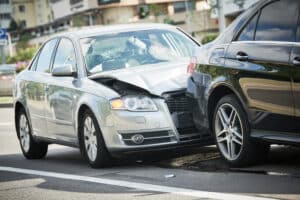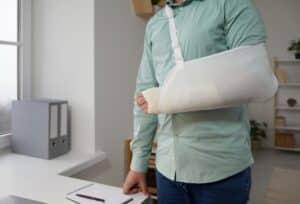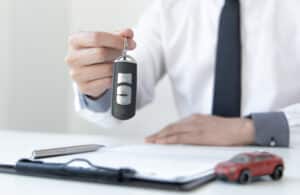Car crashes typically happen when other drivers violate road rules, fail to pay attention to the road or engage in road rage.
If you recently suffered injuries in a rear-end car crash, seek initial (and ongoing) medical treatment, gather evidence, and contact an experienced car accident lawyer.
A skilled attorney can oversee every aspect of your car accident claim or lawsuit, including negotiations with insurance company representatives and litigation in the court system. Your Phoenix car accident lawyer will then do everything possible to highlight the strengths of your case and maximize the overall monetary award you receive.
Where Do Rear-end Traffic Accidents Usually Happen?
Negligent drivers frequently cause rear-end accidents, which tend to happen in specific locations.
One prevalent setting for such collisions is at traffic intersection stop lights. Drivers who fail to notice a red light may inadvertently collide with the vehicle in front of them, highlighting the importance of staying alert and responsive at intersections.
Heavy traffic areas also witness a high frequency of rear-end accidents resulting from others' negligence. Insufficient following distances and inattentiveness prevent drivers from reacting promptly when the vehicle ahead slows down unexpectedly.

Maintaining a safe following distance in congested traffic can significantly reduce the risk of these rear-end collisions.
School zones, designed to prioritize the safety of children, unfortunately, become locations where rear-end traffic accidents may occur. Distractions or speeding in these zones heighten the likelihood of collisions, emphasizing the need for extra caution and adherence to speed limits.
Parking lots, where drivers often navigate tight spaces and encounter pedestrians, are not immune to the consequences of negligence either. Failing to yield or watch for pedestrians in parking lots can bring about rear-end collisions, underlining the importance of maintaining awareness – even in low-speed environments.
Highways and expressways also serve as common stages for rear-end accidents due to others' negligent behavior. Speeding and tailgating, often fueled by impatience or recklessness, escalate the risk of collisions when the vehicle in front slows down unexpectedly.
Responsible driving practices, including maintaining a safe following distance, are critical to lessening such risks on high-speed roads.
Negligent driving and rear-end accidents can even happen in residential areas.
Speeding or disregarding stop signs heightens this risk, especially given the potential presence of pedestrians and children in these areas. In such settings, responsible driving becomes a shared responsibility to ensure the safety of everyone on the road.
Adverse weather conditions may also increase the risk of rear-end accidents resulting from negligence. Failing to adapt to slippery roads during rain or snow increases the likelihood of collisions, emphasizing the importance of adjusting driving behavior based on prevailing weather conditions.
If you suffered injuries in a rear-end accident in one of these locations, an experienced car accident lawyer can swiftly investigate your accident circumstances and file a claim with the appropriate insurance company.
Injuries in Rear-end Accidents
In rear-end collisions that negligent drivers cause, occupants often experience a range of injuries due to the forceful impact. Whiplash is one of the most common injuries, affecting the accident victim's neck and spine. The abrupt forward and backward motion can strain the neck ligaments and muscles, leading to persistent pain and stiffness.
Head injuries are prevalent as well, with occupants at risk of hitting their heads on the steering wheel, dashboard, or side windows. Concussions, lacerations, and contusions are potential consequences, highlighting the importance of wearing seat belts and having properly deployed airbags.
Chest injuries can also occur due to the force of a rear-end collision. Rib fractures, bruising, and soft tissue injuries may result from the force exerted on the chest area after a sudden deceleration.
Lower extremity injuries are also common, especially for drivers. The collision may cause knee injuries as the driver's knees may hit the dashboard or steering column. Fractures, dislocations, and contusions in the legs and knees are potential consequences of a rear-end collision.
Psychological effects, such as anxiety and post-traumatic stress disorder (PTSD), can also appear after a rear-end crash. The sudden and unexpected nature of the accident can leave lasting emotional trauma for both drivers and passengers.
It's crucial for individuals involved in rear-end collisions to seek medical attention promptly, even if their injuries seem minor initially. Early diagnosis and treatment can prevent complications and support recovery from the various injuries sustained in these occurrences.
Important Steps to Take Following a Rear-end Accident
After seeking initial medical treatment and exchanging information with the other driver following a rear-end car accident:

- First, documenting the scene is essential. Use your phone or a camera to take pictures of the accident site, capturing the damage to both vehicles, the surrounding environment, and any relevant road signs or signals. Photograph your injuries as well since visual evidence can play a significant role in establishing the severity of harm.
- Witness information is also invaluable. If bystanders observed the accident, obtain their names and contact details. Their eyewitness accounts can provide crucial perspectives and support your version of events in subsequent legal proceedings.
- Contact law enforcement promptly. Even if injuries seem minor, having an official police report can be essential. Provide a detailed account of the incident, ensuring accuracy in the report, and obtain a copy of this report for your records. Police reports can be crucial evidence for insurance claims and legal actions.
- Preserve any evidence related to the accident and retain damaged clothing, receipts for medical expenses, and any items damaged in the collision. These can be tangible proof of the accident's effects on your life.
- Refrain from discussing the accident on social media. Legal proceedings can use statements made online against you. Insurance companies and opposing legal teams may carefully review your posts, actively searching for any inconsistencies they can exploit.
- Consult with a personal injury attorney to understand your rights and options. An experienced attorney can guide you through the complex process of dealing with insurance companies, pursuing claims, and, if necessary, filing a lawsuit. Ensure you provide your attorney with all relevant details, documents, and evidence.
- Attend all medical appointments and follow the prescribed treatment plan. Consistent medical documentation is crucial for establishing the extent of your injuries and their effects on your life.
Taking these steps can safeguard your interests after suffering injuries in a rear-end car crash and significantly increase your chances of obtaining the full compensation you deserve for your losses.
How Can an Experienced Car Accident Lawyer Help With Settlement or Litigation in Your Case?
Settlement negotiations with the insurance company after a rear-end accident involve a series of steps to reach a fair agreement between the parties involved.
First, the injured party – often with their lawyer's assistance – compiles evidence like medical records, accident reports, and any relevant documentation. This evidence is crucial for presenting a clear picture of the damages incurred.
The accident victim's lawyer then actively communicates with the insurance company. They present the evidence, outlining the victim's injuries, medical expenses, and any other losses suffered due to the accident. During this time, the lawyer must advocate for fair compensation that adequately covers all damages.
Negotiations often involve a back-and-forth dialogue between the lawyer and the insurance company's adjusters.
The lawyer may highlight liability issues, emphasizing the other party's fault and the accident's effect on the injured person's life. This strategic communication persuades the insurance company to offer a settlement that aligns with the victim's damages.
The lawyer actively pursues the best possible outcome for the accident victim's client throughout this process. The attorney may counter offers, provide additional evidence, and skillfully navigate settlement negotiations.
The goal is to secure a settlement that fairly compensates the injured party for medical bills, property damage, and any pain and suffering resulting from their rear-end accident.
If the parties reach an agreement, they document the settlement in writing, concluding the case. The injured party then receives the agreed-upon compensation from the at-fault driver's insurance company, bringing closure to the matter. However, if negotiations prove unsuccessful, the next step is typically moving towards litigation.
Settlement negotiations following a rear-end car accident involve presenting evidence, active communication between the injured party's lawyer and the insurance company, and strategic back-and-forth discussions to reach a fair agreement.
A skilled car accident lawyer plays a crucial role in advocating for the victim's rights and ensuring that the compensation adequately addresses the damages incurred due to the accident.
Compensation for Injuries in a Rear-end Car Accident

Accident victims involved in rear-end collisions may recover compensation to address the damages they suffered.
This compensation restores the victim's financial stability and acknowledges the physical and emotional toll of the accident on their lives:
- Past and Anticipated Medical Costs – Compensation may include reimbursement for medical expenses incurred due to the accident. This covers past medical bills and anticipated future medical costs, including surgeries, rehabilitation, medications, and ongoing treatments.
- Inconvenience – Victims may also receive financial compensation for the inconvenience resulting from the accident. This includes daily life disruptions, such as commuting difficulties, attending to personal matters, and engaging in regular activities.
- Past and Future Pain and Suffering – Compensation for pain and suffering is crucial to address the physical and emotional distress resulting from the accident. This includes the pain experienced during and after the incident, as well as any long-term emotional trauma.
- Loss of Spousal Companionship – In cases where the accident affects relationships, victims may seek compensation for the loss of spousal companionship. This acknowledges the effects on the quality of the relationship due to the injuries sustained.
- Permanent Disfigurement or Disability – If the accident results in permanent disfigurement or disability, victims are entitled to compensation. This includes scars, amputations, or any lasting physical impairment that alters the person's appearance or ability to perform daily activities.
- Lost Quality of Life – Compensation may be available for the diminished quality of life resulting from the accident. This accounts for the negative effect on the victim's ability to enjoy life as they did before the car accident occurred.
- Loss of Earnings – Victims can recover compensation for lost earnings during recovery or rehabilitation. This encompasses income lost due to the inability to work directly resulting from the accident.
- Loss of Earning Capacity – If the injuries sustained in the rear-end accident permanently reduce the victim's ability to earn a living, compensation for loss of earning capacity becomes relevant. This considers all of the effects on a victim's future earning potential.
An experienced car accident lawyer plays an important role in assessing and advocating for the full compensation you deserve for your various losses. They can gather evidence, engage in negotiations with the insurance company, and, if necessary, litigate the case in court to ensure that victims receive fair and comprehensive compensation for their injuries in a rear-end car crash.
Speak with a Knowledgeable Car Crash Attorney Right Away about Your Legal Options

If you recently sustained injuries in a rear-end accident that a negligent driver caused, consult a skilled personal injury attorney in your jurisdiction right away.
Your lawyer can manage all of the legal aspects of your claim and work to pursue the compensation you need for your injuries and losses. Specifically, your attorney can gather important documents, assemble a settlement demand package for the insurance company to review, and pursue a favorable settlement with the at-fault driver's insurance company.
Suppose the insurance company refuses to compensate you fairly for your injuries or denies liability for your accident. In that case, your attorney can litigate your case to an efficient resolution in the court system, such as by taking your case to a civil jury trial.
Throughout the process, your attorney can guide you to make informed decisions, placing you in the best position to recover the total compensation you deserve for your losses.